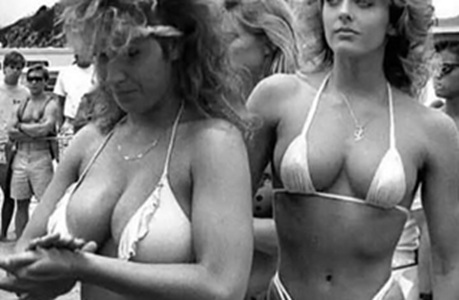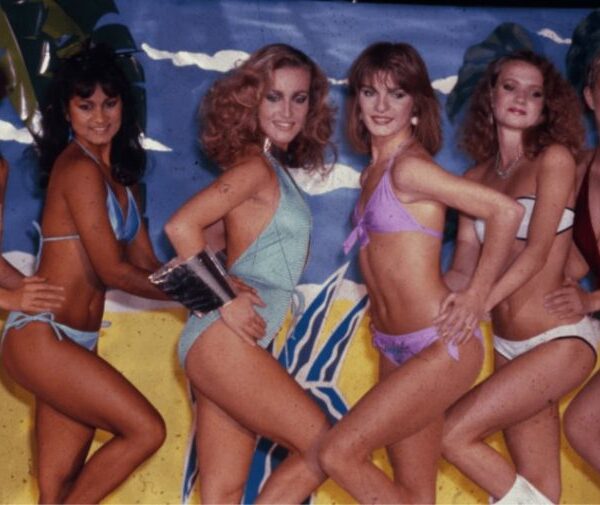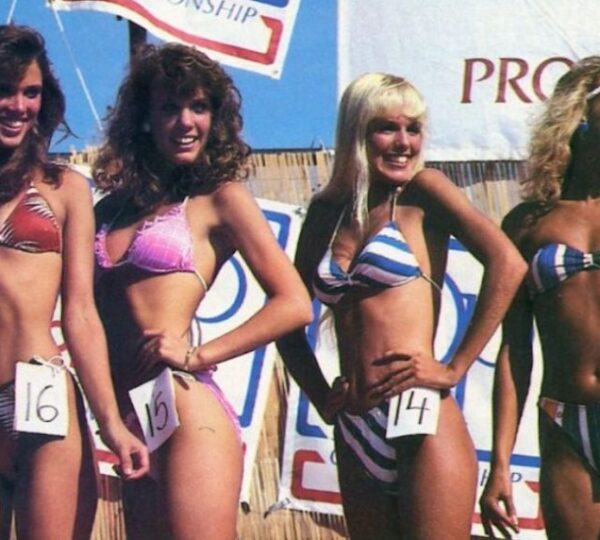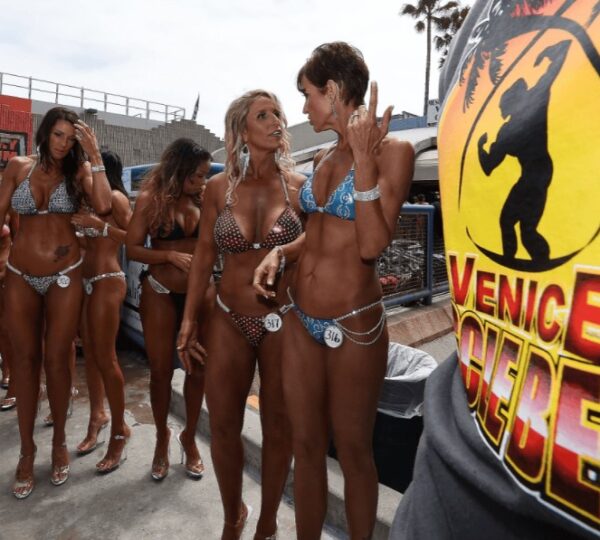
In the summer of 1986, under the warm California sun, a photograph was taken at Venice Beach that would go on to become a quiet but powerful symbol of an unforgettable era. It featured a Miller Lite-sponsored bikini contest, a popular public event that embodied the bold and energetic culture of the 1980s. The photo shows a lively crowd, vibrant beach energy, and young women confidently walking across a stage in revealing swimwear, proudly embracing the spotlight. Among the contestants, model Leslee Bremmer appears in the background, frozen in a moment that speaks volumes about the spirit of the time.
While the specific details of the contest—such as the winner, the prizes, or the number of participants—have largely faded into obscurity, the essence of the event has endured. It represents much more than just a bikini competition; it reflects a pivotal cultural movement that swept across American beaches, televisions, magazines, and fashion runways during the 1980s.

The Rise of Bikini Culture in 1980s America
The 1980s were a transformative decade in American society. It was a time of economic growth, cultural experimentation, and a fascination with image and lifestyle. One of the most visible symbols of this period was the bikini. No longer just a swimsuit, it became a statement piece—an icon of youth, beauty, freedom, and modern femininity.
Bikinis in the 1980s grew bolder in both design and attitude. Cuts became more daring, with high-rise bottoms, thong styles, and strapless tops becoming more common. Neon colors, metallic fabrics, and bold prints reflected the flashy aesthetic of the era. This new style was embraced by both everyday beachgoers and fashion designers alike, leading to the bikini becoming not just acceptable, but celebrated.
The boom in fitness culture during the decade played a significant role. Inspired by stars like Jane Fonda and Arnold Schwarzenegger, Americans became obsessed with gym workouts, aerobics, and achieving the ideal “beach body.” Toned abs, tanned skin, and sculpted figures became mainstream goals, and the bikini became the ultimate way to showcase that hard-earned physique.

Bikini Contests as Public Entertainment
As bikini fashion evolved, so did public fascination. The 1980s saw the rise of bikini contests and beauty pageants across the country, especially in beach cities like Venice, Miami, Huntington Beach, and Daytona. These events were often sponsored by major brands—like Miller Lite, Budweiser, and Venus Swimwear—who saw them as an opportunity to market their products through fun, energetic, and highly visual competitions.
One of the most famous contests of the time was the Miss Hawaiian Tropic International Pageant, which began in the late 1970s and exploded in popularity throughout the ’80s. It attracted contestants from around the world and launched the careers of numerous models, some of whom transitioned into acting, TV hosting, or fashion modeling.

Other events, such as the Venus Swimwear Bikini Contest and the Miller Lite Bikini Contest, provided platforms for young women to display not only their looks, but also their charisma, confidence, and personal style. The contests often included interviews, runway walks, and even talent portions, depending on the format.
While these competitions were undeniably about beauty, they were also seen by many as empowering opportunities for women to take control of their public image and step into the limelight. Participants came from various backgrounds—college students, aspiring models, fitness enthusiasts—and used the contests as a way to gain exposure, build confidence, and have fun.
Media Influence and Celebrity Culture
Bikini contests quickly moved beyond the beach. Television specials, such as the “Swimsuit USA Pageant” or “Beach Heat,” aired nationally and were watched by millions. Magazines like Playboy, Sports Illustrated, and Maxim began featuring bikini models in their spreads, blurring the lines between fashion, entertainment, and sensuality.
Celebrities played a major role in popularizing the bikini lifestyle. Stars like Bo Derek, Pamela Anderson, and Elle Macpherson became icons of beach beauty, often photographed in swimwear for posters, ads, and movies. The idea of a “Baywatch body” or “supermodel swimsuit shoot” was born, further reinforcing the bikini as a cultural touchstone.
Cultural Impact and Social Reflection
The impact of bikini contests and swimwear culture in the 1980s went far beyond the surface. It reflected a deeper societal shift—toward openness, body confidence, and the idea that sexuality and strength could coexist. For many women, these contests were liberating, giving them a platform to express confidence and challenge traditional norms of modesty or behavior.
However, not everyone saw this culture in a positive light. Critics argued that bikini contests objectified women and promoted unrealistic beauty standards. Feminist movements of the time raised valid concerns about the commercial exploitation of the female body and the pressure it placed on women to conform to certain ideals.
Yet, despite the controversies, the overall legacy of 1980s bikini culture is complex. It was both a product of its time and a catalyst for ongoing conversations about beauty, empowerment, and representation.
The Legacy Lives On
Today, the influence of the 1980s bikini boom is still visible. Swimwear fashion continues to evolve, but many of the styles and attitudes born in that decade remain. Bikini contests still exist—though they are more inclusive, diverse, and body-positive than before. Modern events now celebrate different body types, ethnicities, and personal stories, moving away from the narrow definitions of beauty that once dominated the scene.
Yet, despite the controversies, the overall legacy of 1980s bikini culture is complex. It was both a product of its time and a catalyst for ongoing conversations about beauty, empowerment, and representation.
The Legacy Lives On
Today, the influence of the 1980s bikini boom is still visible. Swimwear fashion continues to evolve, but many of the styles and attitudes born in that decade remain. Bikini contests still exist—though they are more inclusive, diverse, and body-positive than before. Modern events now celebrate different body types, ethnicities, and personal stories, moving away from the narrow definitions of beauty that once dominated the scene.
The 1986 Venice Beach photograph serves as a powerful time capsule. It represents not just a single event, but an entire cultural movement—one driven by fashion, fun, media, and a generation’s desire to be seen, celebrated, and remembered. The women in that photo, like Leslee Bremmer, were not just models or contestants—they were cultural ambassadors of a decade defined by freedom, expression, and bold beauty.
As time moves forward, we continue to revisit those moments—not out of nostalgia alone, but because they remind us of how far we’ve come, and how much our perceptions of beauty, body, and empowerment continue to grow.